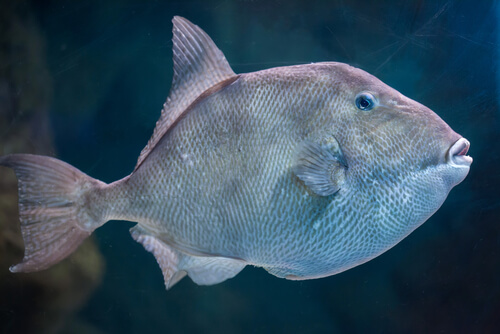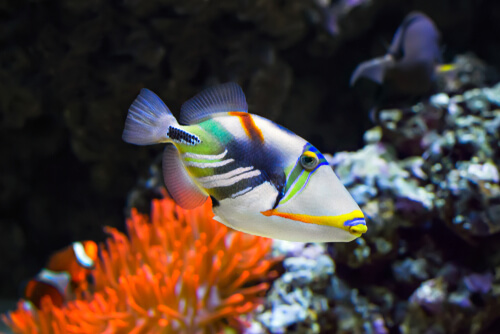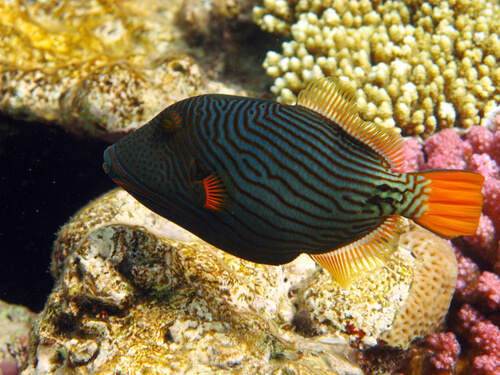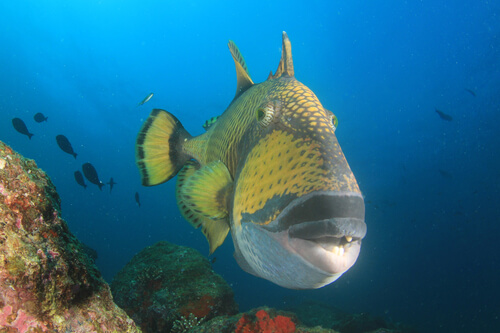
| Kingdom | Animalia |
| Phylum | Chordata |
| Class | Actinopterygii |
| Order | Tetraodontiformes |
| Family | Balistidae |
| Genus | Abalistes, Balistapus, Balistes, Balistoides, Canthidermis, Melichthys, Odonus, Pseudobalistes, Rhinecanthus, Sufflamen, Xanthichthys, Xenobalistes |
| Species | Approximately 40 total |
| Niche | Predatory reef fish |
| Length | 8-20 in (20-50 cm) |
| Weight | 3-10 lb (1.4-4.5 kg) |
| Lifespan | 8 years (up to 20 in captivity) |
| Social Structure | Mostly solitary |
| Conservation Status | “Least Concern” (IUCN Red List). But some species are threatened by the aquarium trade and habitat loss. |
| Preferred Habitat | Shallow coastal environments (reef, lagoon, etc.) |
| Average Egg Size | 0.02 in (0.6 mm) |
| Main Prey Species | Crustaceans, mollusks, small fish, urchins, etc. |
| Predators | Larger fish, sharks, humans. |
The Basics
A triggerfish is a group of marine fishes of the family Balistidae. There are approximately 40 species of triggerfish, all known for their unique oval-shaped bodies. Several species, such as the clown triggerfish (Balistoides conspicillum), are popular aquarium species.
Description
Most triggerfish species grow to 8-20 in (20-50 cm) long and weigh 3-10 lb (1.4-4.5 kg). There are larger members of the family, such as the stone triggerfish (Pseudobalistes naufragium), which grows to more than 30 in (100 cm) long. One uniting feature of all the species in this group is their oval-shaped bodies. Many are brightly colored with interesting patterns and markings.

Triggerfish have large heads that narrow to small mouths. Their eyes are set near the top of their head, about one third the fish’s length back from its mouth. From there, the body narrows towards the anterior of the fish, where the caudal (tail) fin begins. They also have relatively small pectoral fins that they use as their primary mode of mobility, undulating it from side to side slowly. Their anterior dorsal fins are reduced to a set of spines. They also have small modified pectoral fins that house spines but are not highly visible from the exterior. Their jaws are small but strong, each lined with a row of four teeth on each side while the upper jaw also contains an additional set of six plate-like teeth.
Distribution and Habitat
Triggerfish species are generally found in shallow tropical and subtropical waters around the world. More species occur in Indonesia and nearby countries than in other regions of the world.
Within this range, most triggerfish species prefer shallow, coastal marine waters such as those where coral reefs often occur. Here, they can find sections of the reef to shelter in and sandy areas to form their nests. They can also be found in inland lagoons and some species are indeed pelagic, meaning they spend most of their time in open water in search of food and mates rather than staying close to the coast most of the time.

Diet and Predators
Triggerfish use their powerful jaws to their advantage, feeding on various hard items such as crustaceans and mollusks. Sea urchins and other echinoderms are also common items fed on by triggerfish. Some species are also known to seek softer prey such as small fish, while others are vegetarian, feeding primarily on algae or plankton.
Most triggerfish species are relatively small and will face predation from a host of species including larger fish species such as groupers, jacks, and even larger predatory fish like tuna that may visit the reefs. Blacktip reef sharks and other reef sharks will also feed on triggerfish, although their spines help them to deter predators and to hide from them as well.
Both sexes play an important role in the reproductive cycle of triggerfish. Males will typically travel to their traditional spawning sites before mating to establish a territory and prepare a nesting site. Some species build hollow nests and all will fiercely guard their territories to maintain it and attract mates. Males will typically mate with all females that visit their territory.
Reproduction
During courtship, triggerfish will perform various pre-spawning behaviors. Eventually, they will blow water onto the sandy bottom together to create a nesting site and create mock spawning behaviors, touching their stomachs to the seafloor. Eggs are ultimately laid on the seafloor here, where they will attach to particles of sand which helps to keep them in place.
While the eggs develop, females will continue to vigilantly guard the nesting site. She will remain in the area about 15 ft (5 m) from the seafloor, aggressively warding off any invaders such as goatfish, scalpel saw tail fish, and the Moorish idol, another common aquarium species. Males will also remain in the area, typically higher in the water column effectively guarding all the females and eggs within his territory. Females will also roll, fan, and blow water on the eggs, which helps to keep them oxygenated. This behavior is referred to as ‘tending’ and eventually induces hatching of the eggs. In some species such as the crosshatch triggerfish (Xanthichthys mento), this occurs the same day they were laid.
Once the eggs are hatched, females will typically leave the male’s territory, although variations on this behavior also occur within the polygynous group. Young then find their own place on the reef and attempt to avoid predation, particularly during their first few years. At about two years of age, juveniles triggerfish reach sexual maturity and begin the spawning cycle anew. Most species live to about 13 years of age.
Conservation
Most triggerfish are common. However, with the decline of reef habitats around the world due to global climate change and human development, some species face a bleak future. Indeed, some populations are in decline and some species are threatened. This is also due to overfishing and illegal fishing techniques such as dynamite fishing in some countries. Their popularity in aquariums is a further threat to some species but perhaps also represents opportunities for conservation through awareness campaigns.
Fun Facts about Triggerfish!
Triggerfish are a fascinating and beautiful family of fish that are popular as marine aquarium species. This has led to the decline of some species, spurring efforts to learn to spawn these species in captivity to meet this demand.
The Wolverine Fish
As a protection against predators, triggerfish are capable of extending their spines to protect themselves, much like the famous part-man part-wolverine comic books character. They can also use their spines to lock themselves into small areas such as cracks in rocks or reef, making it difficult for predators to remove them from their refuge.
Lunar Cycle
Many triggerfish species spawn based on lunar and tidal cycles. Eggs are usually laid 2-6 days before a full moon and 3-5 days prior to a new moon. Spawning will typically occur 1-5 days prior to a spring tide when the highest tide occurs near sunset. This may help to increase the likelihood that the eggs will experience less tidal current during their early development.

Aggressively Defensive
Triggerfish are known for fiercely defending their territories and, in particular, their eggs and nesting sites. Some will even chase or attack much larger animals, including scuba divers. Although most species are too small to pose any serious threat to humans, the titan triggerfish (Balistoides viridescens), with its large size and strong teeth and jaw, can be dangerous for scuba divers ignoring their warnings or caught off guard by their aggression.
